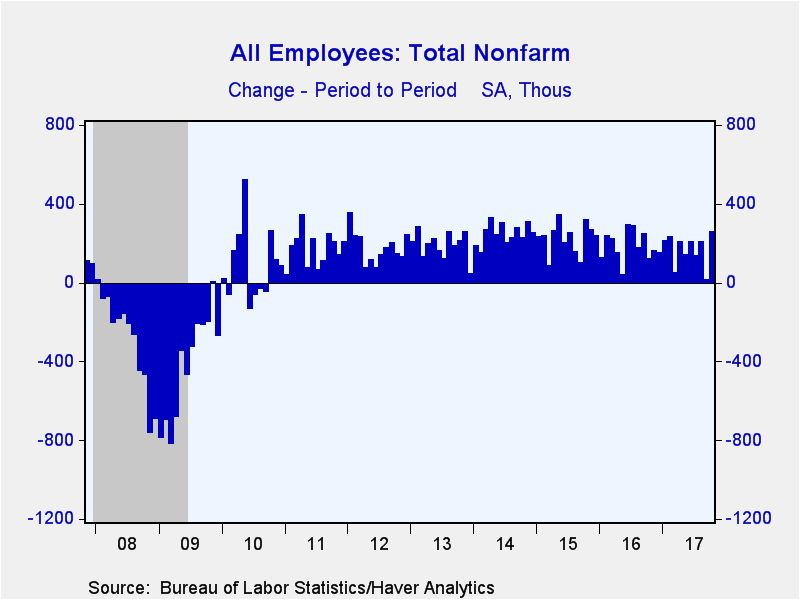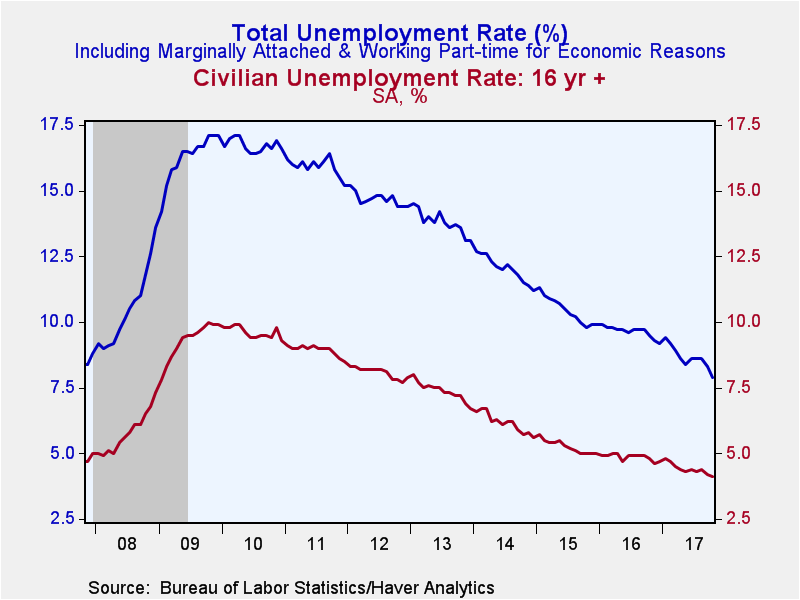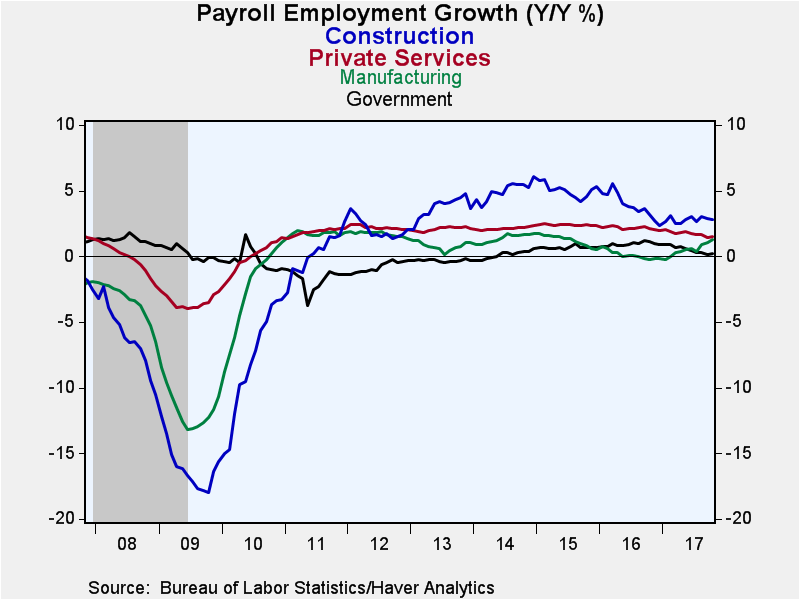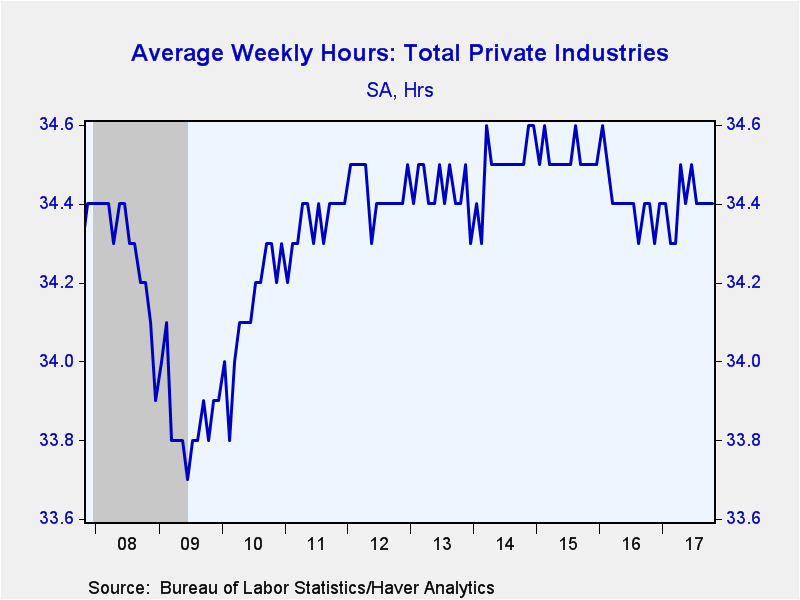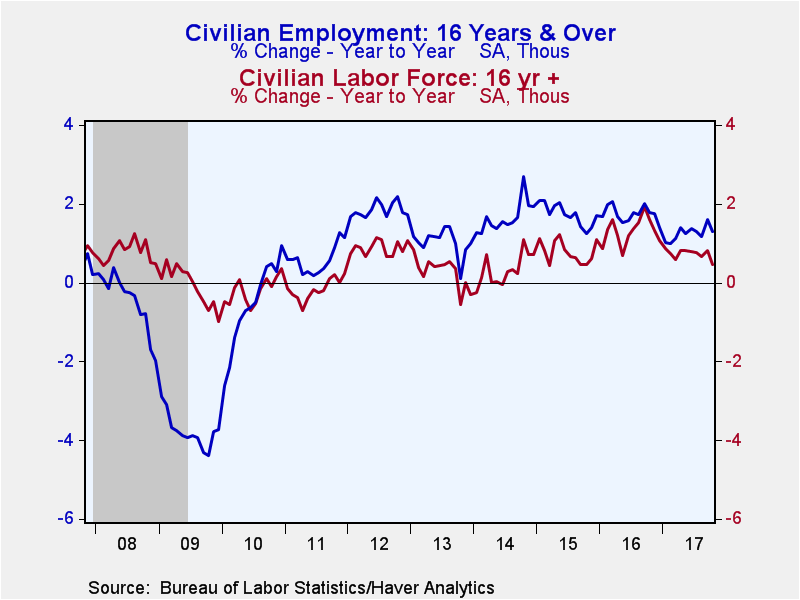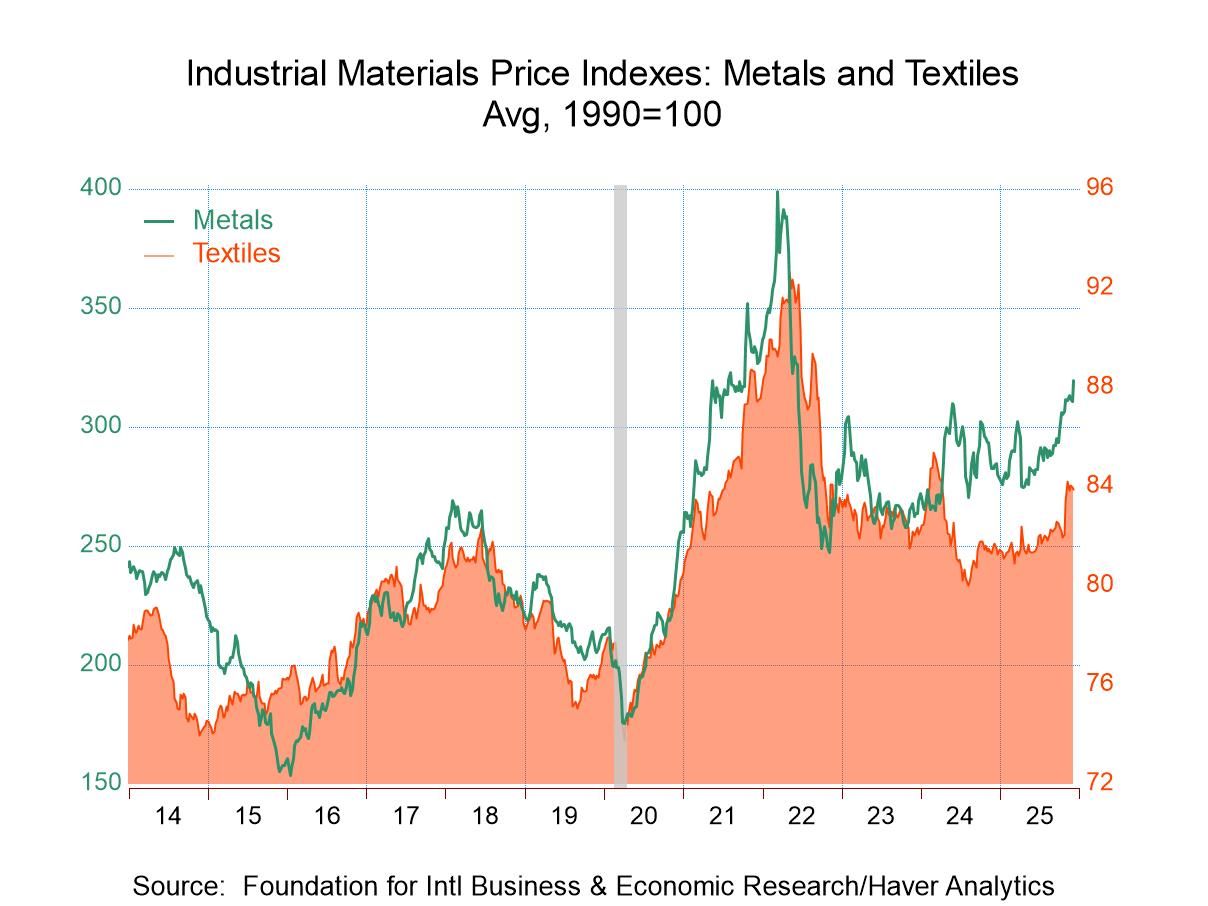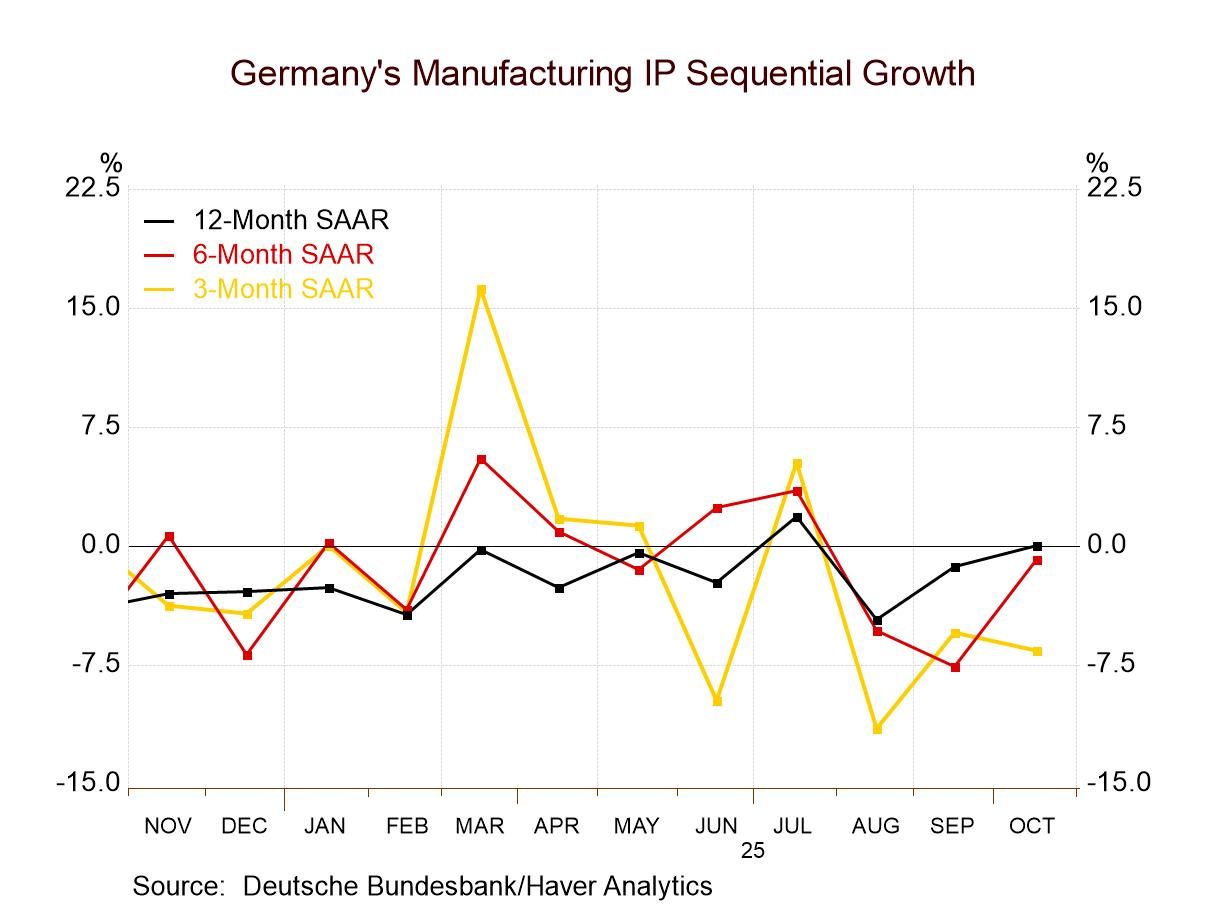 Global| Nov 03 2017
Global| Nov 03 2017U.S. Payrolls Rebound Following Hurricane Loses; Unemployment Dips, but Earnings Hold Steady
by:Tom Moeller
|in:Economy in Brief
Summary
Nonfarm payrolls increased 261,000 (1.4% y/y) during October following an 18,000 September increase and a 208,000 August gain. Together these two figures were revised up by 90,000. A 318,000 increase in payrolls had been expected in [...]
Nonfarm payrolls increased 261,000 (1.4% y/y) during October following an 18,000 September increase and a 208,000 August gain. Together these two figures were revised up by 90,000. A 318,000 increase in payrolls had been expected in the Action Economics Forecast Survey. Last month's employment increase was greatest in the leisure & hospitality sector where hiring rose 106,000, which fully recouped September's decline caused by damage from Hurricanes Harvey & Irma. The unemployment rate fell to 4.1% from 4.2%. An unchanged level had been expected. The overall unemployment rate, including the marginally-attached and those working part-time for economic reasons, fell to 7.9%, down from 9.5% one year earlier. Average hourly earnings were little changed (2.4% y/y). A 0.2% gain had been expected.
From the payroll jobs survey, the 261,000 increase in employment was the strongest since July 2016. Factory sector jobs grew 24,000 (1.2% y/y) after a 6,000 rise. The increase in construction sector employment held steady at 11,000 (2.6% y/y), but mining sector jobs fell 2,000 (+9.2% y/y) after a 900 shortfall.
The jobs increase in the leisure sector was accompanied by a 50,000 rise (2.6% y/y) in professional & business service sector hiring. That followed a depressed 22,000 increase. Temporary help jobs improved 18,300 (4.1% y/y) following a 7,800 rise. Education & health services employment grew 41,000 (2.0% y/y) after a lessened 22,000 increase. Trade, transportation & utilities employment gained 6,000 (0.4% y/y) following a 42,000 strengthening, which was pumped by strong hiring in the passenger transportation sector. Financial activities jobs grew 5,000 (1.8% y/y), the weakest rise since March. Jobs in information services eased 1,000 (-2.1% y/y) following a 3,000 decline. Government sector employment rose 9,000 (0.3% y/y) after a 3,000 rise. Federal government jobs rose 5,000 (0.2% y/y) after a 1,000 increase. State government employment gained 2,000 (-0.0% y/y) following two months of decline. Local area government employment also rose 2,000 (0.5% y/y after a 7,000 rise.
The length of the average workweek held steady at 34.4 hours for the fourth straight month. Hours-worked in the manufacturing sector improved to 41.0 hours, the longest workweek since December 2014. The private service sector workweek improved to 33.3 hours and equaled the average since early 2016. The financial services workweek fell to 37.4 hours from a high of 37.7 hours in the first quarter of 2016. The information sector workweek strengthened to 36.4 from an expansion low of 35.8 hours in September 2016.
 Average hourly earnings slipped negligibly (+2.4% y/y)
following gains of 0.3% averaged during the prior three months. Last month's
performance was restrained by a 0.8% drop (+0.7% y/y) in wholesale trade and a
0.4% decline (+2.3% y/y) in construction. Information sector earnings eased 0.1%
(+3.4% y/y) and factory sector earnings rose a diminished 0.2% (1.6% y/y).
Financial activities earnings jumped a strong 0.4% (3.3% y/y).
Average hourly earnings slipped negligibly (+2.4% y/y)
following gains of 0.3% averaged during the prior three months. Last month's
performance was restrained by a 0.8% drop (+0.7% y/y) in wholesale trade and a
0.4% decline (+2.3% y/y) in construction. Information sector earnings eased 0.1%
(+3.4% y/y) and factory sector earnings rose a diminished 0.2% (1.6% y/y).
Financial activities earnings jumped a strong 0.4% (3.3% y/y).
From the household employment survey, the dip in the unemployment rate to 4.1% reflected a 484,000 fall (+1.3% y/y) in employment which was outpaced by a 765,000 shortfall (+0.5% y/y) in the labor force. This decline produced a drop in the labor force participation rate to 62.7%, its lowest level since May and down from an improved 63.0% in March. The average duration of unemployment eased to 26.0 weeks, but was up from this year's low of 24.1 weeks in March.
By educational attainment, the unemployment rate for those with less than a high school diploma fell to 5.7% from its 2010 high of 14.8%. For individuals with a high school diploma, there was 4.3% joblessness, down from the 2010 average high of 10.3%. Individuals with less than a bachelor's degree realized 3.7% unemployment versus 8.4% in 2010. The unemployment rate for those with a bachelors degree or higher were 2.0% unemployed, down from 2010's 4.7%.
The teenage unemployment rate inched up to 13.7%, but remained near the expansion low. For individuals aged 20-24,s the rate slipped to 7.2%, but has moved sideways for six months. For those aged 25 to 54, the jobless rate dropped sharply to an expansion low of 3.4%. Individuals over age 55 were 3.1% unemployed, also an expansion low.
The labor market data are contained in Haver's USECON database. Detailed figures are in the EMPL and LABOR databases. The expectations figure is in the AS1REPNA database.
| Employment: (SA, M/M Change, 000s) | Oct | Sep | Aug | Oct Y/Y | 2016 | 2015 | 2014 |
|---|---|---|---|---|---|---|---|
| Payroll Employment | 261 | 18 | 208 | 1.4% | 1.7% | 2.1% | 1.9% |
| Previous | -- | -33 | 169 | -- | -- | -- | -- |
| Manufacturing | 24 | 6 | 44 | 1.2 | 0.1 | 1.2 | 1.4 |
| Construction | 11 | 11 | 24 | 2.6 | 3.9 | 5.0 | 5.0 |
| Private Service-Producing | 219 | -3 | 111 | 1.5 | 2.1 | 2.4 | 2.1 |
| Government | 9 | 3 | 24 | 0.3 | 0.9 | 0.7 | 0.1 |
| Average Weekly Hours - Private Sector | 34.4 | 34.4 | 34.4 | 34.4 | 34.4 | 34.5 | 34.5 |
| Private Sector Average Hourly Earnings (%) | -0.0 | 0.5 | 0.1 | 2.4 | 2.6 | 2.3 | 2.1 |
| Unemployment Rate (%) | 4.1 | 4.2 | 4.4 | 4.8 | 4.8 | 5.3 | 6.2 |
Tom Moeller
AuthorMore in Author Profile »Prior to joining Haver Analytics in 2000, Mr. Moeller worked as the Economist at Chancellor Capital Management from 1985 to 1999. There, he developed comprehensive economic forecasts and interpreted economic data for equity and fixed income portfolio managers. Also at Chancellor, Mr. Moeller worked as an equity analyst and was responsible for researching and rating companies in the economically sensitive automobile and housing industries for investment in Chancellor’s equity portfolio. Prior to joining Chancellor, Mr. Moeller was an Economist at Citibank from 1979 to 1984. He also analyzed pricing behavior in the metals industry for the Council on Wage and Price Stability in Washington, D.C. In 1999, Mr. Moeller received the award for most accurate forecast from the Forecasters' Club of New York. From 1990 to 1992 he was President of the New York Association for Business Economists. Mr. Moeller earned an M.B.A. in Finance from Fordham University, where he graduated in 1987. He holds a Bachelor of Arts in Economics from George Washington University.


